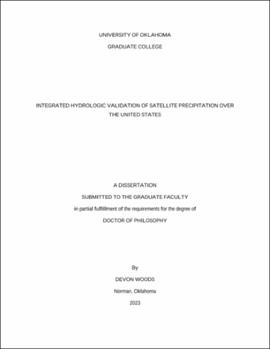| dc.contributor.advisor | Kirstetter, Pierre-Emmanuel | |
| dc.contributor.author | Woods, Devon | |
| dc.date.accessioned | 2024-01-08T15:01:49Z | |
| dc.date.available | 2024-01-08T15:01:49Z | |
| dc.date.issued | 2023-12-15 | |
| dc.identifier.uri | https://hdl.handle.net/11244/340103 | |
| dc.description.abstract | Increasing precipitation extremes across the globe will naturally lead to not only increased flooding but an increase in the occurrences of flash floods, with assessment and prediction of these events becoming more critical every year. Floods are a natural facet of the water cycle and serve as an unmistakable indicator of changes in that cycle globally. As such, the characterization and monitoring of floods also needs to be undertaken at a global scale especially in the face of an ever-changing climate. A key tool in that process is understanding the inherent capabilities of satellite-based precipitation products in their ability to model flood characteristics. Hence, this work focuses on assessing the innate differences in the high-resolution Multi-Radar Multi-Sensor (MRMS) system and the Integrated Multi-satellitE Retrievals for GPM (IMERG) suite of satellite products when used as precipitation forcings to simulate hydrologic outputs through the operational Ensemble Framework for Flash Flood Forecasting (EF5) hydrologic framework. The biases of precipitation presented by satellite products has been well studied, but less has been done to assess how significant these errors persist into physical hydrologic processes especially when compared to ground-based radar estimates. By using each precipitation product as an individual forcing for EF5, the simulated hydrographs can be post-processed where discrete simulated flood events are determined and matched, assessing the ability of each precipitation product to accurately generate reliable simulated representations of flood characteristics. Relationships between these flood characteristics, such as peak flow and flood duration, and physical basin characteristics are investigated. Steps are also undertaken in reimagining the calculation for a timing characteristic of floods in order to increase the accuracy of the estimates, allowing for future integration into the methodologies presented herein. Increasing knowledge regarding the capabilities or deficiencies of satellite precipitation products with respect to flash flood modeling will have implications on the ability to characterize flood events over areas with little or no coverage by ground-based precipitation monitoring networks and subsequently improve flood forecasting operations globally. | en_US |
| dc.language | en | en_US |
| dc.rights | Attribution 4.0 International | * |
| dc.rights.uri | https://creativecommons.org/licenses/by/4.0/ | * |
| dc.subject | Hydrology | en_US |
| dc.subject | Remote Sensing | en_US |
| dc.subject | Hydrometeorology | en_US |
| dc.title | Integrated Hydrologic Validation of Satellite Precipitation over the United States | en_US |
| dc.contributor.committeeMember | Basara, Jeffrey | |
| dc.contributor.committeeMember | Gourley, Jonathan | |
| dc.contributor.committeeMember | Kolar, Randall | |
| dc.contributor.committeeMember | Koch, Jennifer | |
| dc.date.manuscript | 2023-12 | |
| dc.thesis.degree | Ph.D. | en_US |
| ou.group | Gallogly College of Engineering::School of Civil Engineering and Environmental Science | en_US |
| shareok.orcid | 0000-0003-0891-6331 | en_US |

